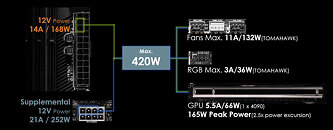TheLostSwede
News Editor
- Joined
- Nov 11, 2004
- Messages
- 18,294 (2.46/day)
- Location
- Sweden
| System Name | Overlord Mk MLI |
|---|---|
| Processor | AMD Ryzen 7 7800X3D |
| Motherboard | Gigabyte X670E Aorus Master |
| Cooling | Noctua NH-D15 SE with offsets |
| Memory | 32GB Team T-Create Expert DDR5 6000 MHz @ CL30-34-34-68 |
| Video Card(s) | Gainward GeForce RTX 4080 Phantom GS |
| Storage | 1TB Solidigm P44 Pro, 2 TB Corsair MP600 Pro, 2TB Kingston KC3000 |
| Display(s) | Acer XV272K LVbmiipruzx 4K@160Hz |
| Case | Fractal Design Torrent Compact |
| Audio Device(s) | Corsair Virtuoso SE |
| Power Supply | be quiet! Pure Power 12 M 850 W |
| Mouse | Logitech G502 Lightspeed |
| Keyboard | Corsair K70 Max |
| Software | Windows 10 Pro |
| Benchmark Scores | https://valid.x86.fr/yfsd9w |
MSI is thrilled to introduce a groundbreaking feature on its X870(E) series motherboards. This innovative is designed with gamers and professionals in mind, provides the extra power required for AI computing and GPU-intensive applications. The supplemental PCIe Power feature, equipped with an integrated 8-pin PCIe power connector, delivers additional power for GPUs demanding higher wattage, ensuring they can achieve their peak performance. Paired with the ATX 3.1 power standard, which can hold up to a 2.5x power excursion for enhanced reliability and better power delivery, this feature ensures stable, efficient, and sustained performance, even under heavy loads. Whether gaming or tackling complex applications, this supplemental PCIe Power offers unmatched reliability and stability for the most demanding environments.
What is Supplemental PCIe Power?
Think of it as an extra battery pack for your motherboard. The system's 12 V power on the 24pin power connector from the motherboard basically handles all the PCIe interface, fans and RGB extensions. Still, the supplemental PCIe power ensures everything runs smoothly when your PC is pushed to the limit—like when running very intensive graphical games or maximizing all the fan dissipation for extreme performance.


The extra power means you can game harder, work smarter, and push your PC to its limits without worrying about power shortages or system instability. Whether running extremely intensive games or running complex AI applications, the Supplemental PCIe Power ensures your system stays stable and performs at its best. It's like knowing your system will keep up no matter what you throw. MSI's X870(E) series motherboards are ready to support the latest ATX 3.1 and PCIe 5.1 standards, providing the ultimate foundation for future-proof computing. With the addition of the Supplemental PCIe Power, users can confidently run the most demanding games and applications, knowing their system is backed by MSI's advanced power management technology and is prepared for future advancements in computing power requirements.
Breakdown of Key Power Management Features:
Let's take the MAG X870 TOMAHAWK WIFI motherboard as an example of how MSI is pushing the boundaries of performance for demanding users. Imagine stacking it with the powerful AMD Ryzen 9950X processor alongside the cutting-edge GeForce RTX 4090 SUPRIM X 24G GPU. At maximum load, these components demand a lot of power. Usually, the motherboard's 24-pin 12 V power connector can only supply a maximum of 168 W. While this might be enough for basic operations, it falls short when trying to drive everything to its peak—especially with fans, RGB lighting, and a beastly GPU like the 4090 connected.
That's where MSI's 8-pin Supplemental PCIe Power Connector steps in. On the MAG X870 TOMAHAWK WIFI, this additional connector provides up to 252 W of extra power, ensuring everything have enough power to run at their full potential. The 24-pin and 8-pin connectors deliver a combine total of 420 W, giving the entire system plenty of power headroom to operate smoothly, even under the most demanding conditions.
What does this mean for users? The Supplemental PCIe Power ensures MSI X870(E) motherboards have the stable, consistent power needed to handle high-end GPU performance and maximized system cooling simultaneously. Whether pushing a 4090 GPU to its limits or adding a second GPU for AI complex computation tasks, these motherboards are fully equipped to handle the next generation of power-hungry components, delivering performance and stability.
MSI's ATX 3.1 / 3.0 Ready PCIe 5 PSU lineup fully supports the additional 8-pin PCIe power demand, offering stable and efficient power delivery across all connected devices. This includes a robust support of all models across MEG, MPG and MAG, ensuring that power distribution is handled efficiently across the motherboard and connected peripherals.
The MSI X870(E) series motherboards with Supplemental PCIe Power will be available on Sept 26th.
View at TechPowerUp Main Site | Source
What is Supplemental PCIe Power?
Think of it as an extra battery pack for your motherboard. The system's 12 V power on the 24pin power connector from the motherboard basically handles all the PCIe interface, fans and RGB extensions. Still, the supplemental PCIe power ensures everything runs smoothly when your PC is pushed to the limit—like when running very intensive graphical games or maximizing all the fan dissipation for extreme performance.


The extra power means you can game harder, work smarter, and push your PC to its limits without worrying about power shortages or system instability. Whether running extremely intensive games or running complex AI applications, the Supplemental PCIe Power ensures your system stays stable and performs at its best. It's like knowing your system will keep up no matter what you throw. MSI's X870(E) series motherboards are ready to support the latest ATX 3.1 and PCIe 5.1 standards, providing the ultimate foundation for future-proof computing. With the addition of the Supplemental PCIe Power, users can confidently run the most demanding games and applications, knowing their system is backed by MSI's advanced power management technology and is prepared for future advancements in computing power requirements.
Breakdown of Key Power Management Features:
Let's take the MAG X870 TOMAHAWK WIFI motherboard as an example of how MSI is pushing the boundaries of performance for demanding users. Imagine stacking it with the powerful AMD Ryzen 9950X processor alongside the cutting-edge GeForce RTX 4090 SUPRIM X 24G GPU. At maximum load, these components demand a lot of power. Usually, the motherboard's 24-pin 12 V power connector can only supply a maximum of 168 W. While this might be enough for basic operations, it falls short when trying to drive everything to its peak—especially with fans, RGB lighting, and a beastly GPU like the 4090 connected.
That's where MSI's 8-pin Supplemental PCIe Power Connector steps in. On the MAG X870 TOMAHAWK WIFI, this additional connector provides up to 252 W of extra power, ensuring everything have enough power to run at their full potential. The 24-pin and 8-pin connectors deliver a combine total of 420 W, giving the entire system plenty of power headroom to operate smoothly, even under the most demanding conditions.
What does this mean for users? The Supplemental PCIe Power ensures MSI X870(E) motherboards have the stable, consistent power needed to handle high-end GPU performance and maximized system cooling simultaneously. Whether pushing a 4090 GPU to its limits or adding a second GPU for AI complex computation tasks, these motherboards are fully equipped to handle the next generation of power-hungry components, delivering performance and stability.
MSI's ATX 3.1 / 3.0 Ready PCIe 5 PSU lineup fully supports the additional 8-pin PCIe power demand, offering stable and efficient power delivery across all connected devices. This includes a robust support of all models across MEG, MPG and MAG, ensuring that power distribution is handled efficiently across the motherboard and connected peripherals.
The MSI X870(E) series motherboards with Supplemental PCIe Power will be available on Sept 26th.
View at TechPowerUp Main Site | Source









 .
.